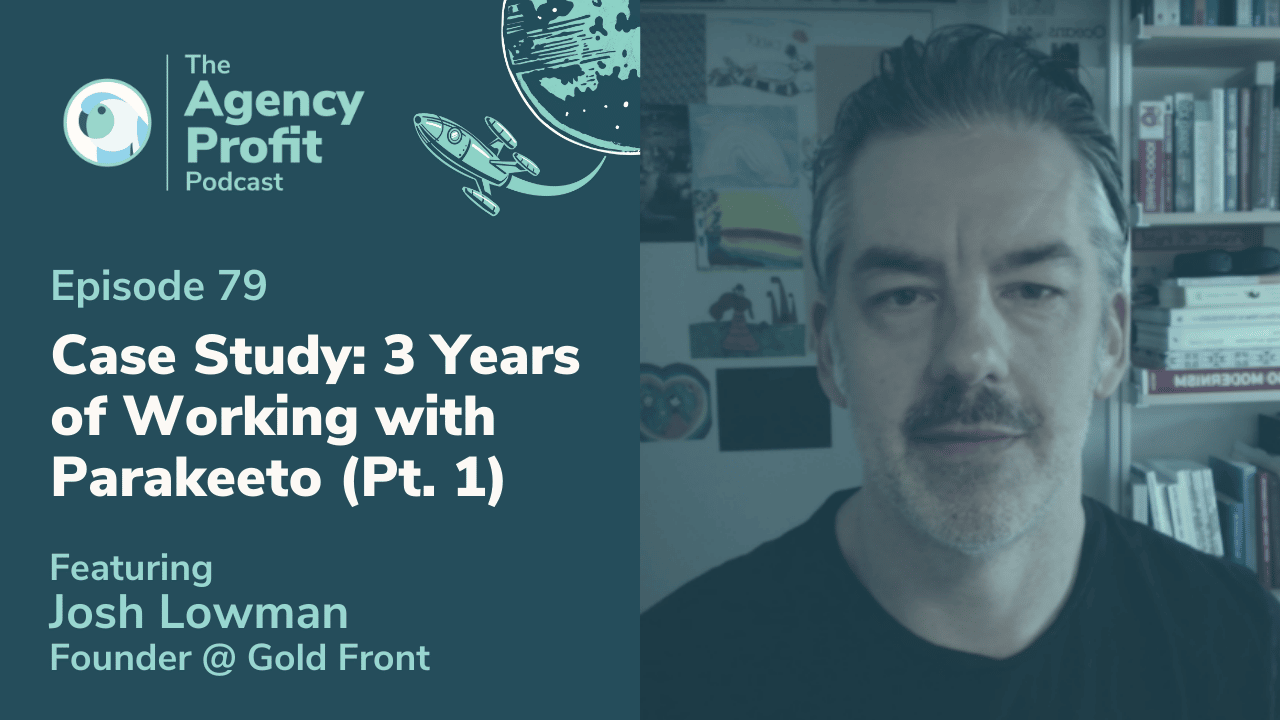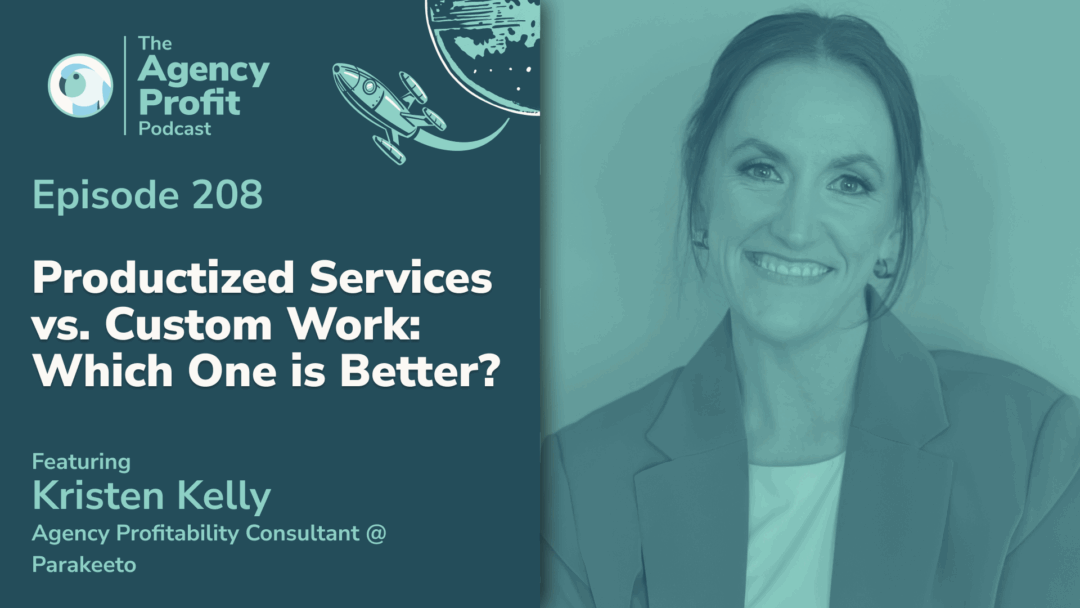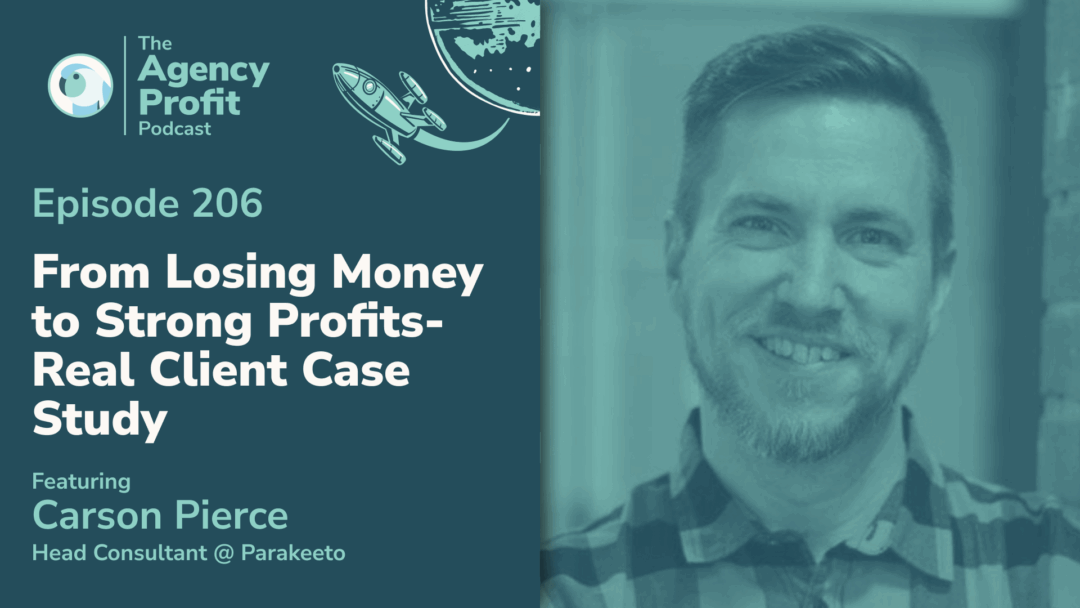We’re switching things up a bit in this edition of Agency Profit Podcast. Josh Lowman of Gold Front and myself have joined forces to examine the last three years working in tandem. It’s been quite the ride, hence we’re providing it in two installments…
About Josh Lowman | Gold Front
Founder and Chief Creative Officer at Gold Front, Josh is a long-term client of Parakeeto, an incredible creative director and entrepreneur. If Gold Front sounds familiar to you, it might be because their Head of Growth, Liston Witherill, appeared on the show last fall.
As you may recall, I’m the COO (fractionally) at Gold Front, and therefore have had the pleasure of working alongside Josh for a number of years. A category design studio, GF is based in SanFran but also has other locations strewn across America. Their primary goal? To help growth-stage startups define and own their own category.
How did Josh get into this space? Well, Gold Front started as a Brand Studio before branching out into Category Strategy, with Josh then realizing the need to combine Brand Execution with Category Creation Strategy. This has led to collaborations with Uber, Robinhood, Newsela, plus oodles more to build category-defining brands.
When John isn’t changing the branding landscape, he’s enjoying downtime with his wife, daughters, and his dog!
Points of Interest…
- What led Josh Towards Agency Ownership? 2:56
- Josh’s Self-Taught Agency MBA 7:10
- 2018 Gold Front, Via an Operations & Profitability Perspective 11:53
- Embracing the Counterintuitive 14:25
- What Josh Learned from Parakeeto 16:19
What Led Josh Towards Agency Ownership?
So many people can benefit from hearing about not just the things that Josh and I have done well together, but also the things that needed figuring out along the way. Prior to diving into that, however, I invite Josh to share just how he wound up doing his own thing:
“I always wanted to have my own business. Aged 10, I wanted to start my own newspaper for me and the neighborhood kids. In High School, I started a small business where I’d help people with their computers, while in college I owned a baseball card business… I always wanted to start an agency, but – to tell you the truth – I was afraid of the humiliation of failure.”
So – initially – Josh did what all tentative entrepreneurs do; he started freelancing instead. With almost 26 years experience in the branding and strategy space, he fully committed to starting Gold Front nine years ago. As for what those first six years (before we met) looked like for Josh?
“It was thrilling and crushing, a mediocre buffet of every kind of experience. Being here in San Francisco, we had a lot of clients that were very exciting to work for – Google, Facebook, Uber, Slack, a bunch of really interesting tech and startup companies in the Bay Area. I feel very fortunate that I got to do that.”
While Josh has enjoyed exciting collaborations (***he delves into one such project with Slack from 5:14 minutes***), it hasn’t always been easy. For example, being a boss responsible for managing people has been tricky, as has the stress of not knowing if there’s enough funds for payroll – the usual stuff.
However, as a mentor of mine once pointed out – all you have to do is figure out how to survive for five to seven years. Then, you’ll probably be okay, plus you’ll see a lot of competitors come and go over that time!
Josh’s Self-Taught Agency MBA
Like most entrepreneurs, Josh has learned through direct experience on the fly. Therefore, I ask about the inflection point whereby he started digging into the business side of running a creative agency.
“I was six years into this and realized I wasn’t fully engaged in the business as an entrepreneur; I was engaged with the business as a creative and as a strategist… People use the term ‘working in the business, or working ON the business’; I was definiately the former. Realizing I needed to take ownership, I started listening to podcasts and reading ALL the books about how to run a company. That’s how I got my DIY MBA.”
And who should Josh stumble across during his quest for knowledge? Just me, on a podcast, discussing agency profitability and a new product Parakeeto was building. He touched base with us, and the rest (as they say) is history – or, for the purposes of this episode, the immediate present!
Regarding Gold Front’s position at the time; the fiscal year 2018, they were at $1.4million, which was up 30% from the year before (30% being the average growth rate each previous year). As with all growing businesses, there were major highs and desolate lows…
“Things would be really busy, and I’d think ‘We’re the next great agency, we’re going to crush it – we’re going to be in the New York times!’ Aaaaand then we’d get slow. I’d take it personally and be like, ‘We’re failures, we’re going to go out of business’.”
You see, it’s all too easy to personalize this stuff, and that’s one of the dangers of owning a business – it REALLY heightens the good times and the bad. Equating how the business is performing with your value as a person is never a good place to be. This is where stability needs to be compounded in your business.
Gold Front 2018, Via an Operations and Profitability Perspective
To put it bluntly, back in 2018, Gold Front’s position from an operations and profitability perspective was – in Josh’s own words…
“Disorganized or non-existent. I wrote down a list you helped with, and it goes: Sales, Operations, Process, Metrics, and Profits. We didn’t have any of those things in place.”
While Josh had his own way of successfully generating sales, it lacked consistency. For example, when he got really busy with work, sales would either go on the back burner or effectively out the window. The same was true for process and operations. There was no set/defined way to SOW, estimate, or figure out how many hours were being spent on a certain project… Say it with me, Josh!
“Because we didn’t have metrics, we didn’t have an idea of the levers we could pull to become more profitable.”
In short, our first flurry of meetings involved me badgering Josh into maintaining sales irrespective of how busy he got. Try as he might to convince me there were literally no hours left, we slowly carved out the times Josh could keep up with it. ***For context, I delve into Gold Front’s utilization curve at the time from 13:50 minutes***
Side Note: The simplest way to model capacity is often to create a “payroll grid”. This means listing all of your delivery and partial delivery employees, along with their weekly capacity and then multiplying that by the number of weeks in a given period.
Want to set benchmarks for your team and agency around utilization? You’d then add delivery/billable expectations and time off / holidays to that grid and model out your capacity and utilization targets for the team.
Example:

Want this exact payroll grid template? It’s included for free in our Agency Profitability Toolkit:
Embracing the Counterintuitive
When you’re working 80 hours a week, trying to get the creative work across the line, sales just seems like the last thing you possibly want to do at that time. That’s the natural handbrake that’s built-in when, as a founder, you’re still doing sales; psychologically you know if the client wants to work with you, then you must deal with the pain of making that happen.
So, for all those reasons, you don’t follow up, you don’t do the business development, because you perceive it as painful. But what if you flip that narrative so you’re turning the work away because you don’t need it, as opposed to fearing the undertaking. There are certain things as the owner of an agency that you need to do for your own health and for the health of the agency, that may seem untenable at the time. And that’s where someone like me comes in!
“For example, doing sales while we still have project work in the short term, seems crazy… but, with a little bit of encouragement or pushing from you, and just knowing that some of the things that are going to be healthy are going to seem counterintuitive at first, but it worked out in the long run.”
What Josh Learned From Parakeeto
As for the other eyeopeners Josh experienced over those first few months/years that we worked together? Well, the importance of taking a holistic approach for starters. For example, ensure everything is connected; your SOW connects to an estimate of how many hours will be spent and how much will be charged for these hours. This involves setting up a project on QuickBooks, which in turn sets up a project in Harvest.
Long story short; Josh used a number of different documents to track all of the data of Gold Front that – up until our collaboration – he hadn’t had sufficient exposure to.
“You actually had a view of what the whole system should be, I didn’t have that at all. I had never done this before. It seemed like you had some prior experience in this and, actually, I don’t really know what your prior experience was. Cause I never really asked you too much, so maybe we’ll get into that today!”
Indeed; I was really at the beginning of doing this as a consultant at that time, and a lot of my ideas have developed in conjunction with working alongside Josh. There’s definitely been an evolution of our thinking over that time – such as how does one approach structure? What is the right structure for an SOW, or an estimate? What is capacity? These things may sound simple, but they’re actually really hard to get a straight answer to.
When you start considering dependencies – like what’s a billable hour, what are all the different things that influence how we think about utilization, average billable rate – and defining those to devise a way to ensure those valuable metrics work together.
When you really start to peel back the onion and ask those hard questions, it can get overwhelming really quickly. And that’s OK; it’s really complex stuff – and that’s where collaborating with someone can really help.
Key Takeaway…
Tools are there to be utilized, people! Once you have the tools to collate your data, then you have access to your company’s metrics, which is always fascinating. You can immediately see which projects are profitable and which aren’t – knowledge that is not only transformative for a company but lays the necessary building blocks for continued growth.
Creating alignment is key; I’ve seen lots of organizations where internally they’ve got several different definitions of the same term. You can imagine how challenging that can be!
That’s all for today’s episode, but it doesn’t have to be the end of your learning journey; make sure you subscribe to our show so you never miss another episode – like our second installment of this collaborative case study – the release date of which is below.
See more from Josh…
- Gold Front
- Twitter @JoshLowman
- LinkedIn @JoshLowman
- Company LinkedIn @gold-front
- Company Twitter @GoldFrontSF
Did you learn anything new from this episode? Let us know in the comments below! We have helpful blogs designed to bolster your agency profitability, such as How To Calculate Your Billable Employee Cost-Per-Hour.
Our next installment of #APP, on February 9th, will see the release of Part 2 of our chat with Josh Lowman. Our previous blog with Megan Kuethen is here…
Agency Profitability Tool Kit
If you’re looking for more resources to help you improve your agency’s profitability, check out the Agency Profitability Tool Kit. It’s full of templates and checklists used when consulting clients. This helps them improve profitability by over 100% in under 60 days.








0 Comments